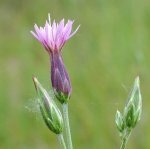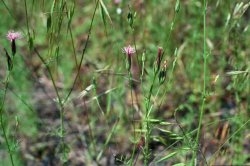Common Crupina
Crupina vulgaris 
Overview
Common Crupina is a winter annual that is native to the Mediterranean.
Although not yet detected in Canada, this plant has invaded over 25,000 ha of rangeland and non-crop areas in Idaho, California, Oregon and Washington state
Habitat
Common Crupina is adapted to a wide range of soils and climate conditions and is usually found in areas with well drained soils. Not only does it invade rangelands and pastures but Common Crupina is also found in gravel pits, along roadsides and rail lines. Rarely is it found in cultivated crops.
It forms dense stands and out-competes native vegetation. Once it spreads into forage crops it can become a contaminant of grass seeds and hay.
This is a prohibited noxious weed in the Seed Act & Regulation which means that crop seeds containing common crupina cannot be imported or sold within Canada.
Identification
A single stem that grows 1 m tall and has branches near the top at the end of each branch is a pink-purple flower surrounded by narrow scale like bracts. Each plant produces about 40 flowers and each flower produces 1-5 seeds. The seeds are large and when dispersed in late June - early July they fall close to the parent plant. Long distance spreading is done by sticking to the animals or by floating down rivers and streams.
Prevention
Prevention includes usin g weed free hay and straw, cleaning equipment and vehicles before moving from one area to another, especially recreational vehicles which are recognized as a major means of spread.
Information and photos taken from the Alberta Invasive Plant Council
Â
Resources
2011 Rural Municipality Distribution Map
2010 Rural Municipality Distribution Map
Alberta Invasive Plant Council Fact Sheet
Back to Terrestrial Invasive Species List
Â
© Copyright 2004-2025 - CMS Made Simple
This site is powered by CMS Made Simple version 1.4.1



